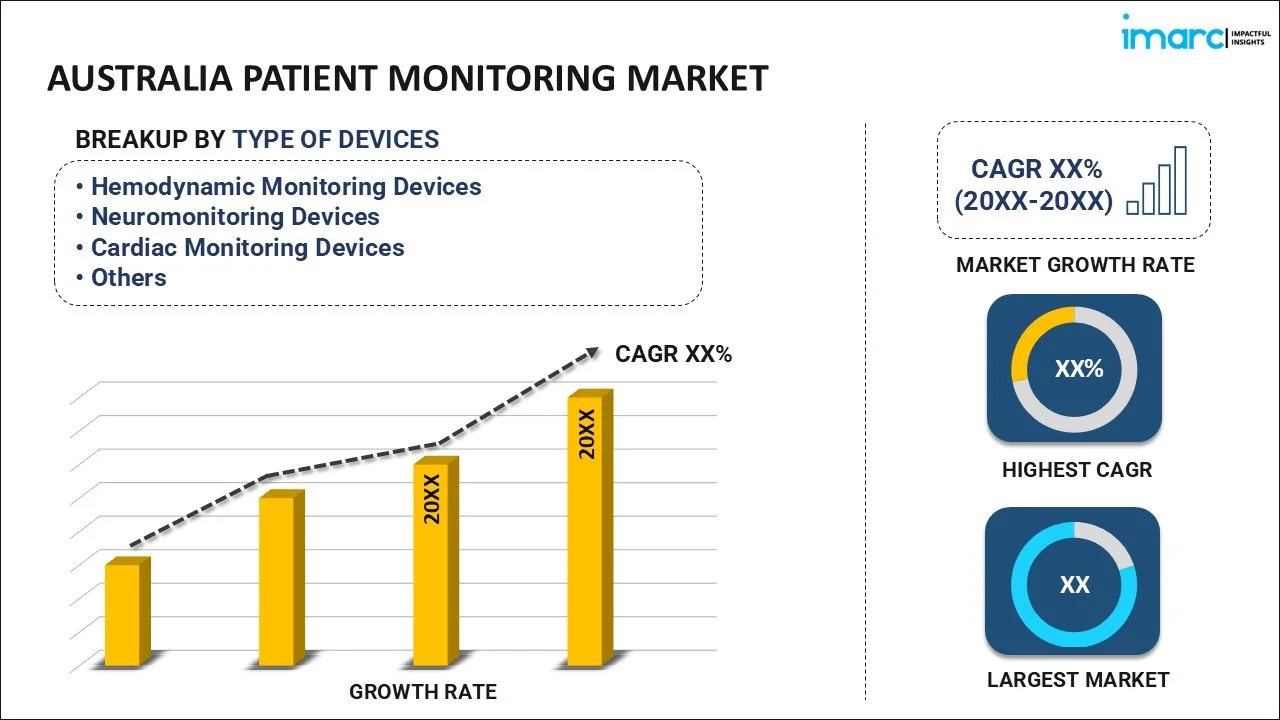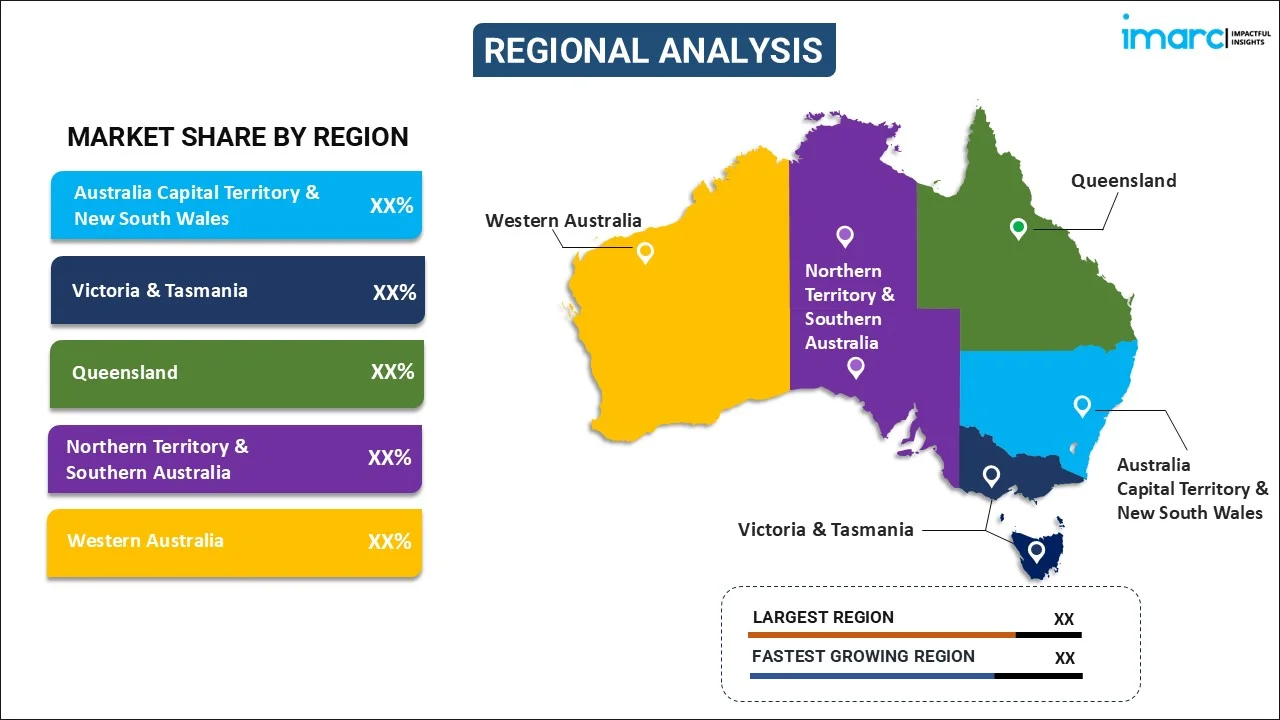
Australia Patient Monitoring Market Size, Share, Trends and Forecast by Type of Devices, Application, End User, and Region, 2025-2033
Australia Patient Monitoring Market Overview:
The Australia patient monitoring market size reached USD 1.3 Billion in 2024. Looking forward, IMARC Group expects the market to reach USD 3.2 Billion by 2033, exhibiting a growth rate (CAGR) of 9.60% during 2025-2033. Key drivers of the Market include the increasing demand for remote monitoring solutions, fueled by technological advancements and the COVID-19 pandemic, the integration of artificial intelligence (AI) and machine learning (ML) for enhanced diagnostics, and the growing preference for home healthcare solutions, especially among the aging population and chronic patients.
|
Report Attribute
|
Key Statistics
|
|---|---|
|
Base Year
|
2024 |
|
Forecast Years
|
2025-2033
|
|
Historical Years
|
2019-2024
|
| Market Size in 2024 | USD 1.3 Billion |
| Market Forecast in 2033 | USD 3.2 Billion |
| Market Growth Rate (2025-2033) | 9.60% |
Australia Patient Monitoring Market Trends:
Adoption of Remote Monitoring Solutions
The increasing need for remote patient monitoring in Australia is transforming the healthcare sector, fueled by technological innovation and the aging population. 4.2 million Australians aged 65 years and above, or 16% of the population, existed as of June 2020, and this percentage is likely to increase to over 22% by 2026. This age-related change coupled with increased usage of remote monitoring devices is changing the care for chronic conditions and minimizing hospital admissions. Remote monitoring allows health professionals to monitor patients' health parameters remotely, enhancing care accessibility, especially in rural and distant locations, and facilitating timely intervention. The COVID-19 pandemic further increased the demand for touchless care, and the proliferation of wearable technology linked to cloud platforms for real-time data processing is augmenting the incorporation of remote patient monitoring into the Australian healthcare system.
Integration of Artificial Intelligence and Machine Learning
Artificial intelligence (AI) and machine learning (ML) are becoming essential components in the Australian patient monitoring market, with the potential to significantly enhance healthcare delivery. A report by Microsoft and the Tech Council of Australia suggests that generative AI could contribute between $5 billion and $13 billion annually to Australia’s healthcare sector by 2030, underscoring the economic value of AI integration. These technologies are improving diagnostic tool accuracy and enabling predictive analytics to identify potential health risks early. AI-driven algorithms analyze data from monitoring systems, providing healthcare professionals with actionable insights that enhance decision-making. Moreover, AI automates routine tasks like data entry, reducing human error and improving efficiency. As healthcare providers continue to leverage AI for better outcomes, its integration into Australia’s patient monitoring sector is expected to grow, driving both operational improvements and economic benefits.
Focus on Home Healthcare Solutions
Australia's patient monitoring market is experiencing a shift toward home healthcare solutions, driven by the aging population and the growing preference for personalized care. Home healthcare devices, such as blood pressure monitors, glucose meters, and pulse oximeters, allow patients to manage their conditions from the comfort of their homes. This trend is particularly beneficial for elderly patients and those with chronic conditions who require continuous monitoring. The integration of home healthcare solutions with healthcare provider systems is facilitating seamless communication, ensuring timely interventions. As home care becomes an integral part of healthcare delivery, the demand for patient monitoring systems designed for at-home use is expected to increase in Australia.
Australia Patient Monitoring Market Segmentation:
IMARC Group provides an analysis of the key trends in each segment of the market, along with forecasts at the country level for 2025-2033. Our report has categorized the market based on type of devices, application and end user.
Type of Devices Insights:

- Hemodynamic Monitoring Devices
- Neuromonitoring Devices
- Cardiac Monitoring Devices
- Respiratory Monitoring Devices
- Remote Monitoring Devices
- Others
A detailed breakup and analysis of the market based on the type of devices have also been provided in the report. This includes hemodynamic monitoring devices, neuromonitoring devices, cardiac monitoring devices, respiratory monitoring devices, remote monitoring devices, and others.
Application Insights:
- Cardiology
- Neurology
- Respiratory
- Fetal and Neonatal
- Weight Management and Fitness Monitoring
- Others
The report has provided a detailed breakup and analysis of the market based on the application. This includes cardiology, neurology, respiratory, fetal and neonatal, weight management and fitness monitoring, and others.
End User Insights:
- Home Healthcare
- Hospitals
- Others
A detailed breakup and analysis of the market based on the end user have also been provided in the report. This includes home healthcare, hospitals, and others.
Regional Insights:

- Australia Capital Territory & New South Wales
- Victoria & Tasmania
- Queensland
- Northern Territory & Southern Australia
- Western Australia
The report has also provided a comprehensive analysis of all the major regional markets, which include Australia Capital Territory & New South Wales, Victoria & Tasmania, Queensland, Northern Territory & Southern Australia, and Western Australia.
Competitive Landscape:
The market research report has also provided a comprehensive analysis of the competitive landscape. Competitive analysis such as market structure, key player positioning, top winning strategies, competitive dashboard, and company evaluation quadrant has been covered in the report. Also, detailed profiles of all major companies have been provided.
Australia Patient Monitoring Market News:
- In September 2024, Australia's Department of Health and Aged Care launched a telehealth service to provide virtual nursing for aged care residents. A tender has been issued to select telehealth providers to deliver person-centered care through video consultations, offer staff training, assess technology needs, and ensure accessible information for residents and families.
- In July 2024, KORE and mCare Digital launched the mCareWatch 241, a smartwatch designed for virtual patient monitoring. Aimed at individuals needing emergency assistance, such as seniors or those with disabilities, it features SOS alerts, GPS tracking, heart rate monitoring, fall detection, and more. Available in Australia for $499, the watch includes a mobile app and web dashboard, providing enhanced safety and independence for users.
- In June 2024, Prevounce Health launched the Pylo GL1-LTE, a remote blood glucose monitoring device with cellular connectivity for reliable data transmission. Integrated with Prevounce’s remote care platform, it syncs with other connected devices, supporting diabetic patients' glycemic control. The launch follows $7 million in Series A funding and continued growth in remote care services.
Australia Patient Monitoring Market Report Coverage:
| Report Features | Details |
|---|---|
| Base Year of the Analysis | 2024 |
| Historical Period | 2019-2024 |
| Forecast Period | 2025-2033 |
| Units | Billion USD |
| Scope of the Report |
Exploration of Historical Trends and Market Outlook, Industry Catalysts and Challenges, Segment-Wise Historical and Future Market Assessment:
|
| Type of Devices Covered | Hemodynamic Monitoring Devices, Neuromonitoring Devices, Cardiac Monitoring Devices, Respiratory Monitoring Devices, Remote Monitoring Devices, Others |
| Applications Covered | Cardiology, Neurology, Respiratory, Fetal and Neonatal, Weight Management and Fitness Monitoring, Others |
| End Users Covered | Home Healthcare, Hospitals, Others |
| Regions Covered | Australia Capital Territory & New South Wales, Victoria & Tasmania, Queensland, Northern Territory & Southern Australia, Western Australia |
| Customization Scope | 10% Free Customization |
| Post-Sale Analyst Support | 10-12 Weeks |
| Delivery Format | PDF and Excel through Email (We can also provide the editable version of the report in PPT/Word format on special request) |
Key Questions Answered in This Report:
- How has the Australia patient monitoring market performed so far and how will it perform in the coming years?
- What is the breakup of the Australia patient monitoring market on the basis of type of devices?
- What is the breakup of the Australia patient monitoring market on the basis of application?
- What is the breakup of the Australia patient monitoring market on the basis of end user?
- What is the breakup of the Australia patient monitoring market on the basis of region?
- What are the various stages in the value chain of the Australia patient monitoring market?
- What are the key driving factors and challenges in the Australia patient monitoring market?
- What is the structure of the Australia patient monitoring market and who are the key players?
- What is the degree of competition in the Australia patient monitoring market?
Key Benefits for Stakeholders:
- IMARC’s industry report offers a comprehensive quantitative analysis of various market segments, historical and current market trends, market forecasts, and dynamics of the Australia patient monitoring market from 2019-2033.
- The research report provides the latest information on the market drivers, challenges, and opportunities in the Australia patient monitoring market.
- Porter's five forces analysis assist stakeholders in assessing the impact of new entrants, competitive rivalry, supplier power, buyer power, and the threat of substitution. It helps stakeholders to analyze the level of competition within the Australia patient monitoring industry and its attractiveness.
- Competitive landscape allows stakeholders to understand their competitive environment and provides an insight into the current positions of key players in the market.
Need more help?
- Speak to our experienced analysts for insights on the current market scenarios.
- Include additional segments and countries to customize the report as per your requirement.
- Gain an unparalleled competitive advantage in your domain by understanding how to utilize the report and positively impacting your operations and revenue.
- For further assistance, please connect with our analysts.
 Inquire Before Buying
Inquire Before Buying
 Speak to an Analyst
Speak to an Analyst
 Request Brochure
Request Brochure
 Request Customization
Request Customization




.webp)




.webp)












